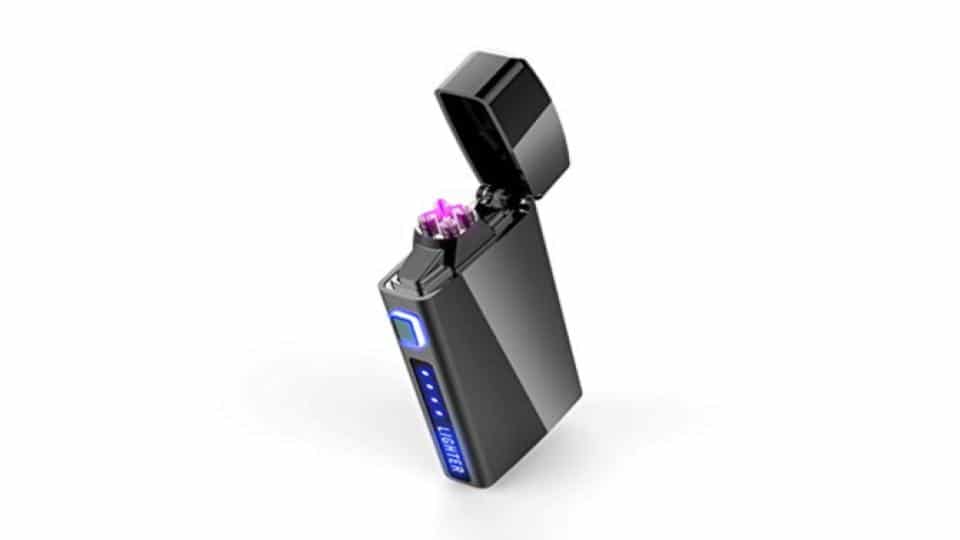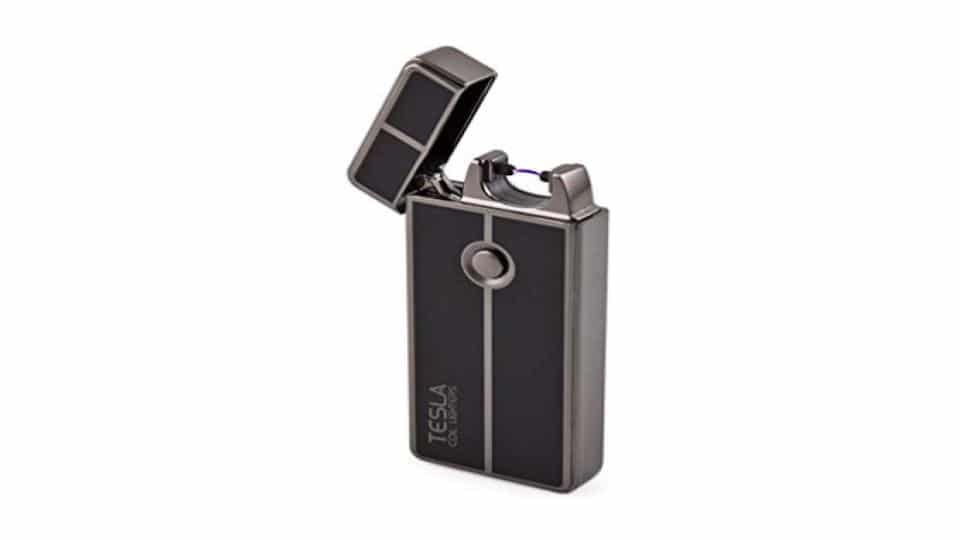10 Types of Lighters You Should Know About

Table
of
Contents
Lighters
aren’t
just
for
smokers!
It
is
one
of
the
best
handy
tools
to
have
anytime
and
anywhere.
From
your
car
to
your
camping
kit,
it
is
a
good
idea
to
have
a
lighter
within
reach.
It
is
affordable,
compact,
lightweight,
and
versatile,
making
it
a
must-have
in
your
survival
bag.
With
a
lighter,
you
can
start
a
fire,
cook
food,
purify
water,
protect
yourself
against
animals
in
the
wild,
and
stay
warm,
among
others.
Nonetheless,
they
aren’t
all
the
same.
With
this,
read
on
as
we
talk
about
some
of
the
most
common
types
of
lighters,
so
you
can
pick
the
right
one.
What
Are
the
Different
Types
of
Lighters?
1.
Plastic
Spark
Wheel
Lighters
This
is
the
most
popular
lighter
you
will
find
in
the
market
today.
It
is
the
category
where
most
cigarette
and
disposable
lighters
belong.
As
the
name
implies,
it
has
a
spark
wheel
that
is
responsible
for
producing
ignition,
and
in
turn,
will
generate
a
flame.
The
body
of
the
lighter
is
often
made
of
plastic.
Think
of
Bic
as
the
perfect
example.
Meanwhile,
its
wheel
is
made
of
serrated
steel.
Below
the
wheel,
you
will
find
the
flint.
Push
the
wheel
with
enough
pressure,
and
it
will
rub
against
the
flint,
creating
a
spark.
You
will
also
find
a
plastic
lever
under
the
spark
wheel,
which
is
what
releases
fuel
as
the
valve
opens.
While
most
of
these
lighters
are
refillable,
most
people
opt
to
throw
them
away.
The
quality
isn’t
the
best,
so
durability
can
be
an
issue.
Plus,
they
are
so
cheap,
so
a
lot
would
rather
buy
a
new
one
instead
of
going
through
the
hassle
of
refilling
its
fuel.
Take
note
of
some
of
its
limitations.
For
instance,
it
often
does
not
last
more
than
3,000
lights.
Plus,
it
is
not
windproof.
Some
might
not
also
like
how
the
spark
wheel
can
easily
get
hot
the
longer
the
flame
sustains.
2.
Piezo
Ignition
Lighter
A
type
of
ignition
that
you
will
most
commonly
find
in
portable
stoves
and
gas
grills,
piezo
ignition
is
utilized
in
many
lighters
today.
It
operates
under
the
principle
of
piezoelectricity.
The
latter
refers
to
the
capability
of
a
material
to
have
an
electrical
charge
after
the
application
of
mechanical
stress.
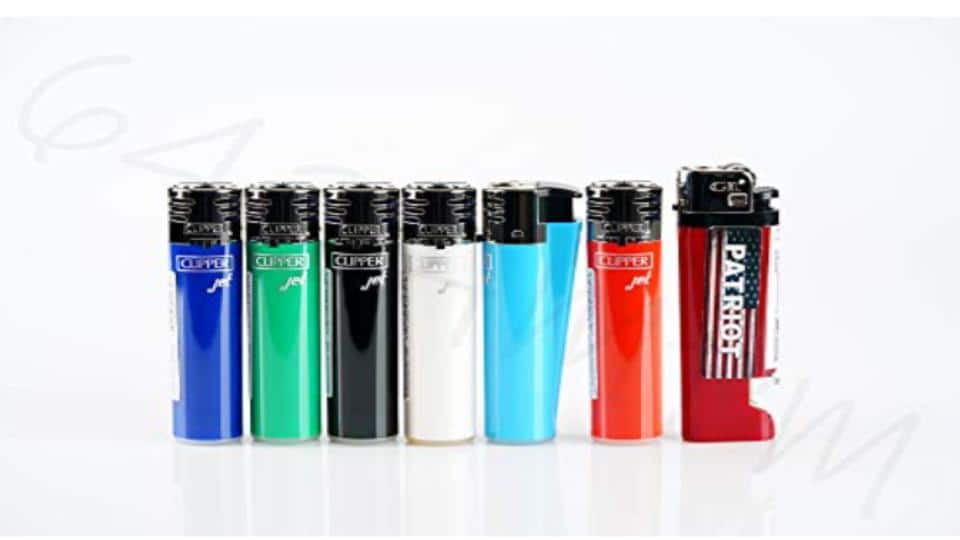
This
type
of
lighter
is
almost
similar
to
a
spark
wheel.
The
main
difference,
however,
is
that
there
is
no
metal
wheel.
Instead,
it
has
a
plastic
that
pushes
the
quartz
element
to
activate
the
spark.
Voltage
is
created,
hitting
the
fuel
inside
the
lighter
to
create
a
flame.
Its
lifespan
is
usually
shorter
than
a
plastic
spark
wheel
lighter,
which
is
often
only
1,800
lights.
Using
butane
as
a
fuel,
it
is
also
a
disposable
lighter
that
is
common
amongst
smokers.
While
many
are
refillable,
people
will
not
bother
adding
more
butane
since
it
is
cheap
getting
a
new
lighter.
It
is
easy
to
light
even
when
your
hand
is
sweaty
or
when
you’re
using
gloves.
Unlike
the
spark
wheel,
it
has
no
sharp
edges.
Nonetheless,
it
also
has
some
drawbacks.
For
instance,
some
might
not
like
how
it
does
not
work
in
wet
and
windy
conditions.
3.
Windproof
Lighter
When
it
comes
to
windproof
lighters,
there
is
one
popular
brand
that
most
of
you
are
probably
aware
of—Zippo.
For
more
than
a
hundred
years,
it
has
been
a
big
hit
in
the
global
market.
It
is
larger
than
the
two
lighters
mentioned
above.
It
has
a
spark
wheel,
which
you
have
to
press
to
ignite
the
flame.
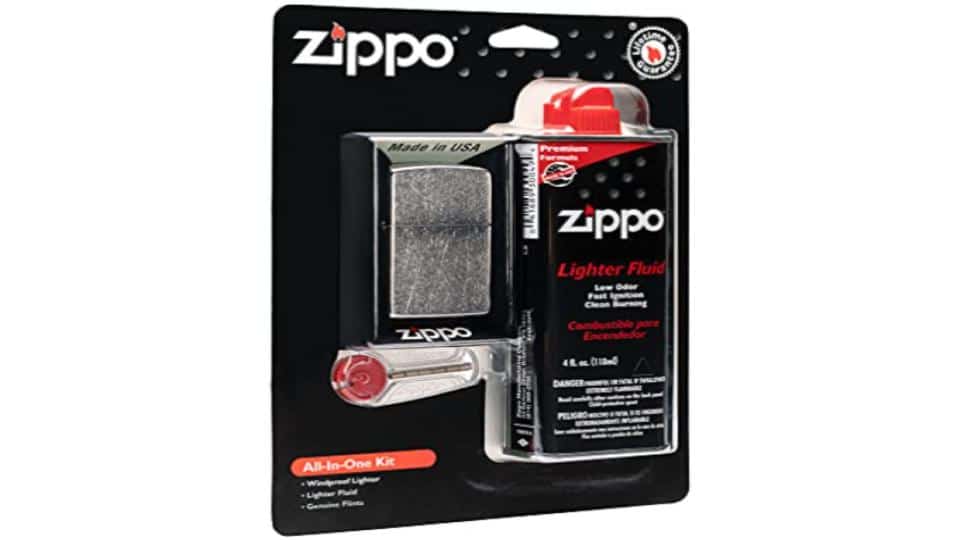
One
of
the
best
things
about
a
windproof
lighter
is
that
it
stays
lit,
even
when
you
take
your
hand
off
the
spark
wheel.
Even
when
it
is
cold
and
windy,
the
flame
stays
on.
The
only
way
it
goes
off
is
by
closing
its
lid.
Otherwise,
the
flame
will
stay
alive
just
like
a
lit
candle.
Another
good
thing
about
windproof
lighters
is
that
they
can
last
a
long
time,
especially
if
you
choose
Zippo.
You
will
need
a
replacement
for
the
wick
and
flint,
but
the
lighter
itself
is
tough.
However,
take
note
that
it
is
prone
to
air
exposure.
Not
to
mention,
it
uses
a
lot
of
fuel
since
it
stays
lit
unless
you
close
the
lid.
On
average,
it
might
take
up
to
10
days
before
you
need
to
refuel.
It
will
depend
on
several
factors,
such
as
the
extent
of
use.
4.
Torch
Lighter
The
name
itself
should
already
give
you
an
idea
of
the
design
of
this
lighter.
It
has
butane
in
a
pressurized
chamber.
Meanwhile,
the
fuel
forces
through
the
lighter’s
nozzle.
Here,
it
creates
an
intense
and
strong
flame,
which
is
powerful
enough
to
light
cigars.
A
good
thing
about
torch
lighters
is
that
it
allows
the
users
to
aim
the
flame
in
any
direction.
You
can
even
point
it
up
or
down.
As
long
as
you
are
holding
the
trigger
button,
the
flame
will
stay
lit.
If
there
is
one
thing
that
you
might
not
like
about
this
kind
of
lighter,
it
would
be
its
inefficiency.
It
uses
a
lot
of
butane,
so
make
sure
that
you
always
have
a
can
of
spare
fuel
for
a
refill.
5.
Plasma
Lighter
Claiming
to
be
better
than
butane,
plasma
lighter
is
another
type
that
is
worth
considering.
It
does
not
use
gas
to
generate
a
flame.
Instead,
it
uses
plasma,
the
fourth
state
of
matter.
It
started
as
a
Kickstarter
project
and
became
more
popular
around
the
world
because
it
is
a
greener
alternative
to
conventional
lighters.
In
a
plasma
lighter,
a
high-voltage
electrical
current
goes
through
two
nodes.
In
turn,
it
produces
a
highly-charged
plasma
arc.
It
creates
heat
that
will
light
an
object,
such
as
a
candle
wick.
Among
others,
one
of
the
best
things
about
plasma
lighters
is
that
they
are
flameless.
Not
to
mention,
they
are
also
hotter
than
your
usual
lighter
and
a
great
option
when
you
are
in
windy
environments.
Aside
from
having
no
fuel,
we
also
love
how
it
is
rechargeable,
so
you
can
minimize
waste
compared
to
using
traditional
plastic
lighters.
A
plasma
lighter
also
has
several
shortcomings.
For
instance,
the
battery
will
often
need
a
replacement.
Also,
the
charging
time
can
be
long
and
might
not
last
long
between
charges,
depending
on
the
quality
of
the
lighter
you
are
using.
6.
Utility
Lighter
Also
called
a
candle
lighter,
the
most
recognizable
characteristic
is
the
long
neck.
It
is
the
same
lighter
that
you
use
for
lighting
a
gas
stove.
It
is
useful
if
you
want
to
cook
at
the
campsite
as
well.
With
a
long
neck,
it
is
easier
to
light
a
candle,
stove,
or
grill
without
your
hand
getting
burnt.
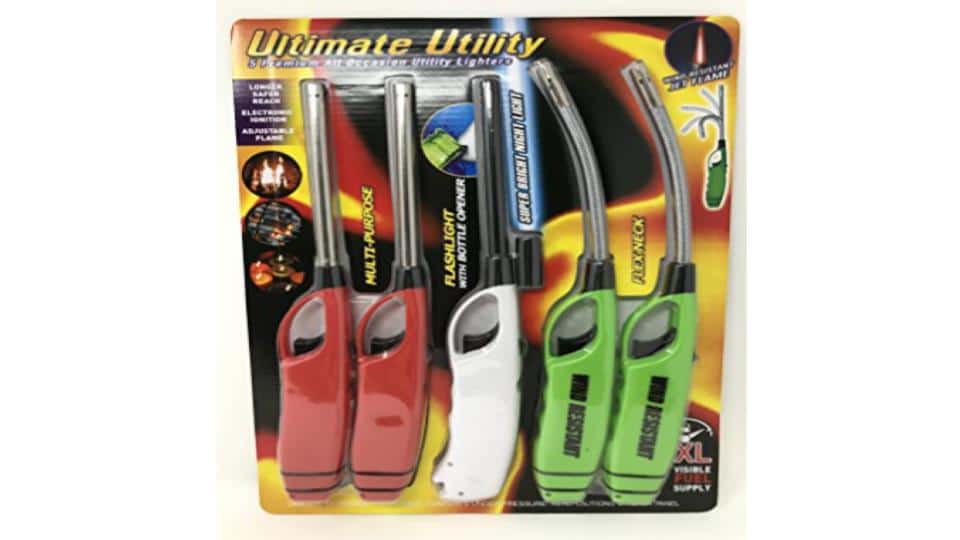
These
lighters
can
have
a
rigid
or
flexible
neck.
The
latter
is
more
versatile
because
you
can
twist
the
neck
depending
on
the
direction
where
you
will
need
the
flame.
These
lighters
are
refillable,
making
them
economical.
Nonetheless,
since
they
are
affordable,
most
people
consider
them
as
disposable
lighters.
7.
Electric
Coil
Lighter
A
flameless
lighter,
it
is
one
of
the
most
innovative
lighters
you
can
use.
It
has
a
built-in
battery
instead
of
using
butane
or
any
other
fuel.
It
is
through
the
battery’s
electricity
that
the
coil
inside
the
lighter
heats
up.
It
has
two
ceramic
nodes
that
create
electrical
energy,
which
is
what
will
ignite
a
flame.
You
can
charge
these
lighters
in
a
micro
USB
port,
just
like
your
smartphone.
Meaning,
you
can
also
use
your
portable
power
bank,
making
sure
that
the
lighter
is
available
when
you
need
it
the
most.
However,
it
has
limited
applications.
Most
people
use
it
only
for
smoking.
With
the
coil,
you
cannot
light
just
anything.
Hence,
it
is
not
a
good
choice
if
you
need
a
lighter
for
camping
or
emergency
preparedness.
8.
Permanent
Match
If
you
are
looking
for
a
lighter
that
will
make
a
great
addition
to
your
survival
kit,
then
it
is
hard
to
go
wrong
with
a
survival
match.
As
the
name
implies,
it
looks
like
a
classic
match.
It
has
a
spark
stick
with
a
screwed
wick.
Meanwhile,
the
main
body
of
the
lighter
is
a
chamber
that
is
filled
with
fuel.
Compared
to
a
standard
match,
the
flame
that
it
creates
is
more
wind-resistant.
Not
to
mention,
it
is
longer-lasting.
Nonetheless,
be
careful
with
the
advertisements
of
some
manufacturers
regarding
the
number
of
lights,
since
they
are
often
more
than
the
true
capability.
9.
Floating
Lighter
The
name
itself
is
already
a
clue
of
what
this
lighter
is
like.
This
is
perfect
if
you
are
often
in
the
water,
such
as
for
those
who
love
boating.
It
has
an
innovative
construction
with
a
buoyant
body,
so
it
will
float
in
the
water.
Not
to
mention,
it
is
also
waterproof,
so
you
can
use
it
even
when
it
is
wet,
making
it
great
for
survival
situations.
10.
Capsule
Lighter
It
is
the
smallest
of
all
the
lighters
on
the
list,
making
it
easy
to
bring
anytime
and
anywhere.
Some
people
wear
it
as
a
necklace,
so
it
is
always
accessible.
Depending
on
the
specific
brand
and
model,
it
can
also
be
waterproof.
Nonetheless,
because
it
is
small,
the
fuel
will
not
last
long.
It
is
not
for
everyday
use
but
only
for
emergencies.
Tips
for
Choosing
a
Lighter
It
is
not
enough
that
you
pick
a
lighter
that
generates
a
flame.
Consider
other
factors
in
picking
the
right
one,
including
the
following:
Purpose
One
of
the
first
things
to
do
is
to
determine
what
you
need
the
lighter
for.
Is
it
for
cigarettes
or
cigars?
Will
you
be
using
it
for
cooking
at
home
or
at
the
campsite?
Or
are
you
buying
one
that
will
make
a
great
addition
to
your
survival
kit?
By
knowing
your
purpose,
it
is
easier
to
narrow
down
the
choices.
Size
From
compact
to
bulky,
lighters
are
available
in
different
sizes.
The
biggest
are
the
ones
that
are
designed
for
lighting
candles
or
stoves.
Meanwhile,
the
smallest
are
those
that
you
can
use
for
survival,
making
them
easy
to
bring
wherever
you
go.
Nonetheless,
take
note
that
the
smaller
ones
usually
have
the
least
capacity.
Fuel
The
type
of
lighter
that
you
choose
will
dictate
the
fuel
that
it
has.
Butane
is
the
most
common,
especially
in
refillable
lighters.
Naphtha
is
another
option,
which
has
a
saturated
cloth
wick
and
fiber
that
absorbs
fluid.
Meanwhile,
you
will
also
find
others
without
fuel,
especially
those
with
an
electric
mechanism.
Why
You
Need
a
Lighter
If
you
are
a
smoker,
chances
are,
you
always
have
a
lighter
with
you.
Nonetheless,
even
if
you
do
not
smoke,
you
will
need
one
for
the
following
reasons.
Start
a
Fire
One
of
the
best
reasons
to
have
a
lighter
is
to
start
a
fire.
Forget
about
the
traditional
mode
of
survival
wherein
you
need
stones
to
manually
create
flames.
With
a
lighter,
things
will
be
easy.
You
can
start
a
fire
to
keep
you
warm
in
the
campsite,
to
boil
water,
or
cook
food,
among
other
things.
Open
a
Bottle
Do
not
attempt
to
open
a
bottle
with
your
teeth!
It
is
better
to
use
a
lighter
instead.
Many
of
them
are
designed
with
a
solid
and
flat
body,
which
can
be
useful
when
a
bottle
does
not
have
a
twist
cap.
Seal
a
Rope
or
Cord
If
you
are
using
nylon
or
rope,
such
as
when
you
are
setting
up
temporary
shelter
in
the
campsite,
you
will
have
another
good
reason
to
own
a
lighter.
It
can
seal
the
ends
that
you
have
just
cut,
which
will
prevent
fraying.
Light
a
Candle
Especially
if
you
live
in
an
area
where
power
outage
is
common,
you
will
benefit
from
having
a
lighter
nearby.
This
will
let
you
easily
light
a
candle
without
the
need
for
using
matches.
If
you
enjoy
romantic
dinners
or
you
love
the
scent
of
candles,
a
lighter
is
handy
to
have.
FAQs
What
are
old
lighters
called?
Old
lighters
are
called
Feurzeug
or
Dobreiners
Lamp.
It
was
named
after
the
German
chemist
who
was
credited
for
being
the
inventor
of
the
lighters
that
we
know
today.
What
are
the
most
popular
lighter
brands?
Some
of
the
most
popular
global
lighter
brands
are
Zippo,
Bic,
Dunhill,
Coleman,
Lois,
Clipper,
MK,
and
Calico.
What
kind
of
a
lighter
is
Zippo?
Zippo
is
a
wind-proof
metal
reusable
lighter.
It
is
more
expensive
than
traditional
disposable
lighters,
but
it
is
worth
every
dollar
because
it
is
beautiful
and
long-lasting.
When
it
no
longer
lights,
all
that
you
need
to
do
is
to
refill
it
with
butane.
Final
Thoughts
Lighters
exist
in
all
shapes
and
sizes.
Whether
it
is
for
cigarettes,
cigars,
candles,
camping,
or
survival,
among
other
situations,
picking
the
right
one
is
essential.
Some
of
the
most
common
types
of
lighters
you
will
find
in
the
market
include
plastic
spark
wheel,
piezo
ignition,
windproof,
plasma,
electric
coil,
and
capsule.



